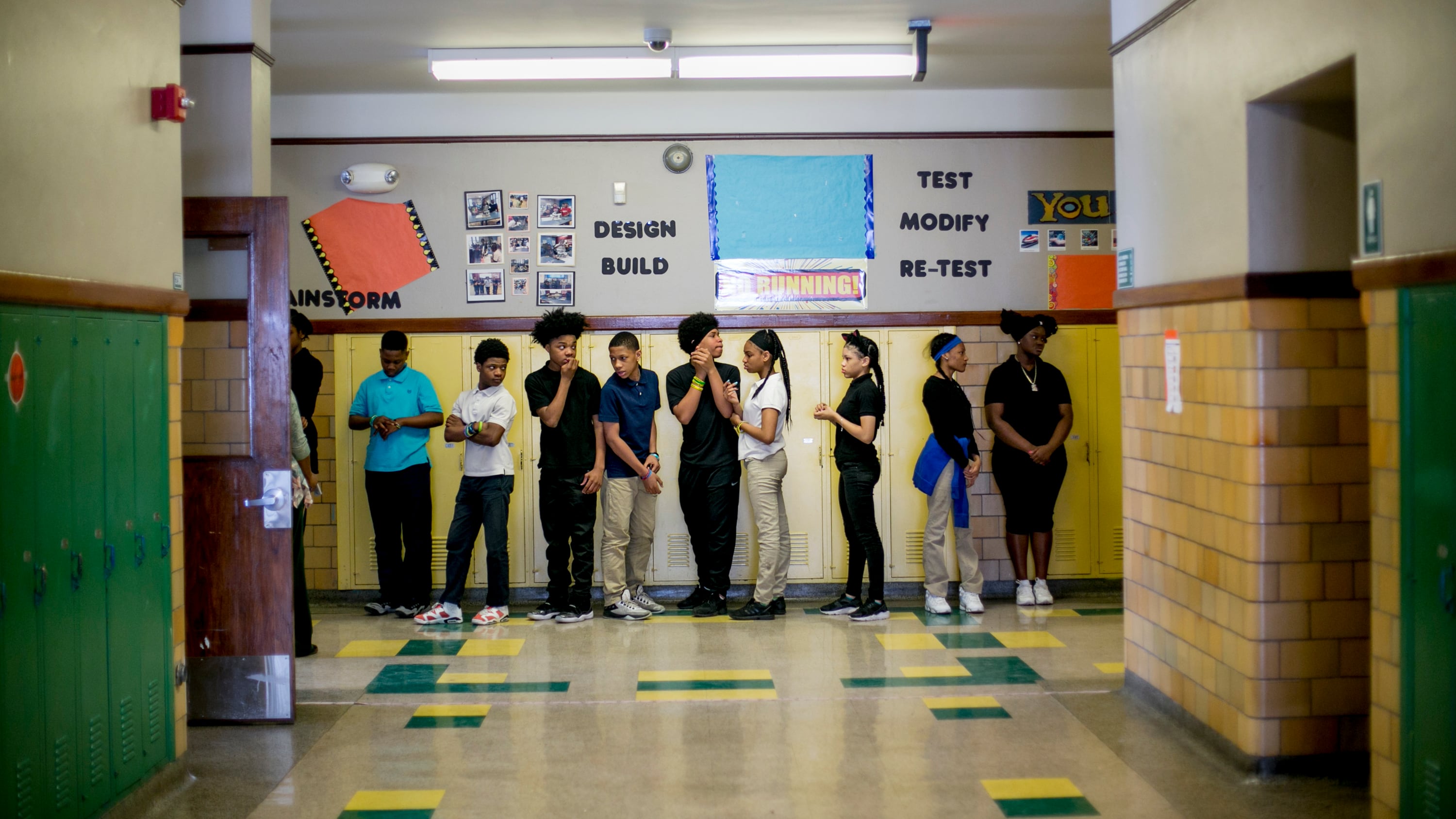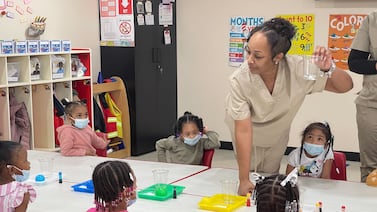Sign up for Chalkbeat Detroit’s free daily newsletter to keep up with the city’s public school system and Michigan education policy.
Wednesday’s official student headcount for Michigan schools could be more crucial than ever, as districts where enrollment has declined since the pandemic began are now facing the expiration of federal COVID relief.
The federal aid known as Elementary and Secondary School Emergency Relief, or ESSER, helped schools weather the pandemic in several ways. Some districts used a portion of that aid to cushion the fiscal blow from enrollment losses. But ESSER funds will run out in September 2024, and in response, districts could be forced into some budget cuts in the near future as long-term enrollment drops persist.
The stakes are high across the nation, including in Michigan, where the pandemic accounted for more than half of the 9% decline in statewide student enrollment over the past decade, according to a Chalkbeat analysis. In Michigan, where enrollment is tied to school funding, each student leaving local public schools could cost a district nearly $10,000 in annual funding without the backstop of COVID aid.
The end of ESSER funding could be especially challenging for high-poverty districts, which have typically received more federal relief and spent their funds at a slower pace than their more affluent counterparts.
And the end of federal COVID relief is approaching as students continue to struggle, both academically and emotionally, from the pandemic.
The end of ESSER money could on its own drive down funding significantly in many districts in Michigan and elsewhere. A national analysis estimates that on average, the loss of the federal pandemic funding will cause a drop in revenue of about $1,000 per student.
“There’s certainly more question marks than there are exclamation points at this point when it comes to where this is going to go,” said Robert McCann, executive director of K-12 Alliance, an organization that represents school superintendents across Michigan. “Every superintendent right now is looking at their budget, and trying to figure out how to best maintain some of those programs that were created during the pandemic.”
Michigan enrollment declines exacerbate spending cliff
School systems across Michigan were provided roughly $6 billion through ESSER that districts used for a variety of programming families wanted. Districts like Flint Community Schools that lost students throughout the pandemic also used ESSER funding to counteract the loss of state aid that followed enrollment declines.
No more ESSER dollars means Flint and other districts can only rely on that strategy for so long. Although that funding hasn’t run out yet, districts will use Wednesday’s student count to help determine their budgets for the 2024-25 school year.
Become a Chalkbeat sponsor
COVID funding “has allowed us to have a fund balance to cushion us for the next couple of years,” said Kevelin Jones, Flint’s superintendent.
“We need every dime that we can get our hands on,” Jones said. “When you’re losing 50 to 100 students every year, it means that we can not properly staff and meet the needs of every one of our scholars.”
Jones added: “Once this fund balance is gone, we are back in the same situation that we were in prior to the pandemic of being in the red.”
The district has lost 66% of its student population, or roughly 5,700 students, in the past decade.
Alena Zachery-Ross, who has led Ypsilanti Community Schools since 2018, said high-poverty districts like hers are in dire straits. Ypsilanti saw a 280-student dip in K-12 enrollment at the start of the 2020-21 school year. The district is also still making up for the loss of students who left for neighboring districts in the wake of a district consolidation in 2013.
“For those of us who really need that additional support, who benefit by having social workers in every building, instructional coaches in every building, climate and culture coaches in every building, we use those [Count Day] dollars to provide those extra supports that are needed,” said Zachery-Ross.
Michigan counts students on two official days during the school year, this Wednesday and Feb. 7. District principals have led a daily attendance campaign in anticipation of Wednesday, and have sent letters home to families reminding them of Count Day’s significance.
Budget cuts can be especially challenging in districts that used ESSER money to maintain staff and programming that they would not have been able to afford otherwise.
This summer, the Detroit Public Schools Community District, Michigan’s largest school district, moved to cut and consolidate central office and support staff to make up for a loss of 2,000 students during the pandemic. DPSCD enrolled roughly 50,000 students pre-pandemic.
Heading into Wednesday, DPSCD is budgeting for at least 48,200 students, according to Superintendent Nikolai Vitti. The district is tasking its principals with creating their own Count Day plans, and they have received additional funding for those activities.
Become a Chalkbeat sponsor
“You really go to any school during Count Day, you will see something different happening,” Vitti said at a DSPCD meeting on Monday. “We have to be realistic with how that drives funding and to make that a unique type of day for students.”
In some places, the cuts could extend beyond staff and programming. Districts like Flint and Grand Rapids Public Schools, where there’s been a 20% drop in enrollment over the past decade, have recently weighed whether to close underutilized schools in the coming years.
Some school leaders with rosier enrollment statistics or projections argue the ESSER spending cliff is no more daunting than the challenges cash-strapped districts have contended with before.
For the first time in over a decade, Coloma Community Schools may see a bump in enrollment according to preliminary figures ahead of Count Day, said Superintendent Dave Ehlers, who leads the rural, high-poverty school district on the shore of Lake Michigan.
The end of ESSER, he said, won’t come as much of a loss for his district, which enrolls roughly 1,300 students. Most of the district’s dollars went toward providing new technologies and social-emotional learning.
“I think we’re gonna be in a good spot,” Ehlers said. “We’ve invested well and made sure that we did good things with it, but we’re prepared to go with our regular school budget and be okay.”
Stiles Simmons, superintendent of Westwood Community Schools outside of Detroit, said financial belt-tightening has kept the district of nearly 1,500 students afloat amid previous enrollment losses. This past year, when the district gained 91 students, the district’s corresponding increase in state aid went directly to build up the district’s general fund balance.
How badly districts are faring enrollment-wise may also guide lawmakers’ decisions regarding next year’s school aid budget.
This summer, lawmakers approved a $21.5 billion budget that raised the state’s per-student allowance by nearly $500 and boosted funding for at-risk students and special ed services.
“What we’re hoping is that the legislature is going to look at that budget that got passed this year and say ‘That needs to be the baseline going forward, not an exception that we’re going to start scaling back from,’” McCann of K-12 Alliance said.
Become a Chalkbeat sponsor
Ethan Bakuli is a reporter for Chalkbeat Detroit covering Detroit Public Schools Community District. Contact Ethan at ebakuli@chalkbeat.org.







